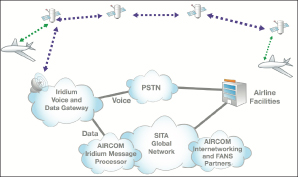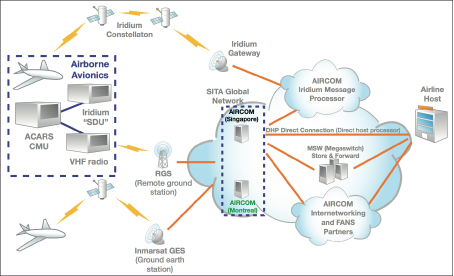An overview of the Iridium system as it pertains to the air transport industry (ATI) in general, and SITA’s decision to offer its customers AIRCOM cockpit communication services based on Iridium services in particular
by SITA and Iridium
With AIRCOM Iridium services, SITA is able to offer airlines the ability to carry out voice and Aircraft Communication Addressing & Reporting System (ACARS) communications worldwide, taking advantage of the inherent characteristics and resulting benefits of the Iridium satellite network – which include global coverage as well as low avionics installation costs.
Iridium is known as offering a globally available communications service worldwide, including over remote and Polar Regions, and its applicability and usefulness to the ATI has increasingly become a matter of industry-wide interest. For this reason, it is crucial that Iridium’s capabilities in the context of the ATI be properly discussed and understood by providers and users alike.
Avionics equipment installation for AIRCOM Iridium services is both simpler and less expensive than for other satellite systems, which in turn lowers the deterrents normally faced by customers when planning which aircraft to retrofit with communications equipment. In general, AIRCOM Iridium services allow aircraft, which would otherwise not be equipped with VHF (very high frequency), ACARS or SATCOM (Satellite Communications) systems, to benefit from real-time aircraft voice and data communications for all phases of flight. These benefits will become even more numerous as additional applications, such as those for ATS (Air Traffic Service) and FANS (Future Air Navigation Systems) communications, become approved over the Iridium link.
Cellular network boom
The Iridium satellite communications system was first envisioned before the boom of cellular networks as a mobile communications system that would allow users to be reached and make calls from anywhere in the world. Today this vision is a reality: Iridium’s constellation of 66 low earth orbiting (LEO) satellites allows communication from any global location, and supports voice, data, fax and messaging traffic to and from aircraft avionics.
Through the Iridium system, SITA is therefore able to offer voice and ACARS services to suitably equipped aircraft anywhere in the world. This gives SITA AIRCOM users an additional way of accessing the AIRCOM network and services, complementing VHF, VHF Digital Link (VDL) and Inmarsat SATCOM, and allows customers to take advantage of Iridium avionics’ reduced upfront acquisition and aircraft installation costs. The Iridium services used to support aeronautical operations include:
- voice calling (telephony) – allowing flight crews in aircraft equipped with voice-capable Iridium avionics to place or receive voice calls as they would from any terminal connected to the Public Switched Telephone Network (PSTN).
- the short burst data (SBD) service – a simple, efficient satellite network transport protocol ideally suited to transmit ACARS blocks between the communications management unit (CMU) and AIRCOM’s central datalink host processor. SBD is a packet-bearer function that provides a non circuit-switched, high-capacity means of transmitting and receiving individual packets of data to/from the AIRCOM network.
- the router-based unstructured digital inter-working connectivity solution (RUDICS) – an enhanced gateway termination and origination capability for circuit-switched data calls across the Iridium satellite network. RUDICS offers an optimized data connection service for various end-to-end data applications or solutions. RUDICS allows custom devices in the field to connect to ground-based servers by encapsulating the transmitted data in TCP/IP (Transmission Control Protocol / Internet Protocol).
The nominal throughput for data communications over Iridium is 2.4 kbps (kilobit per second) for circuit-switched mode (i.e., telephony and RUDICS) and approximately 1.2 kbps effective rate for packet-data mode (i.e., SBD) over a dedicated channel. SITA offers the following services to customers (Figure 1):
- voice over Iridium – circuit-switched voice and data calls
- ACARS over Iridium – using SBD (packet-data mode) via units that can send/receive AEEC (Airlines Electronic Engineering Committee) 618 blocks.
A future assessment may also be conducted on the suitability of RUDICS (circuit-switched mode) to carry ACARS and other messages; for the time being, however, SBD is being used for the AIRCOM ACARS services since most avionics implementations of ACARS-capable Iridium equipment in the market use this protocol.
Cockpit voice services using the Iridium network are handled as follows:
Aircraft-originated voice calls
Crew-initiated calls are received by the satellite constellation and subsequently routed to the Iridium gateway. The gateway in turn directs the call to the intended recipient’s telephone number via the PSTN (Public Switched Telephone Network). Depending on the specific avionics configuration and clearances required to place aircraft-originated voice calls, the recipient’s number may be dialed directly by flight crews using numeric or pre-programmed entries. Once Iridium is approved for safety services, Air Traffic Control (ATC) short codes – which are decoded at the Iridium gateway and subsequently routed to the appropriate PSTN (Public Switched Telephone Network) number – may also be used to place aircraft calls. The charges associated with aircraft-originated calls are invoiced by SITA to the registered user of the subscriber identity module (SIM) card installed in the avionics equipment (typically the airline or aircraft operator), and are billed in 20-second increments.
Ground-originated voice calls
Ground users may place a call to an aircraft via two methods: direct international connection or two-stage calling. In both cases the call is routed through the PSTN to the Iridium gateway, but the calling rates using the direct international connection may be considerably higher depending on the charges levied by the ground user’s local long-distance service provider. With a direct international connection, the call originator dials the long-distance exchange number assigned to the Iridium constellation (i.e., 8816) plus the eight-digit Iridium transceiver number assigned to the SIM card installed in the avionics unit. The charges associated with this call are entirely invoiced by the local long-distance provider to the call originator. In two-stage calling, the call originator dials a U.S.-based gateway access number and is then prompted to enter the twelve-digit Iridium telephone number (i.e., 8816 plus the eight-digit Iridium transceiver number assigned to the SIM card installed in the avionics unit). The charges associated with this call are classified into two categories: those invoiced by the local long-distance provider to the call originator to access the U.S.-based gateway number, and those invoiced by SITA to the registered user of the avionics equipment for the gateway aircraft portion of the call (billed in 20-second increments).
Network topology
From a network topology perspective (Figure 2), the ACARS traffic over the Iridium link is mostly managed and handled by the AIRCOM data link traffic (ADLT) processor in the same way as the traffic from other ACARS links (i.e., VHF, VDL and Inmarsat SATCOM). However, there are two main differences in how traffic over the Iridium link is processed. The first is the use of an AIRCOM Iridium message processor to convert SBD messages to/from AEEC618 blocks.
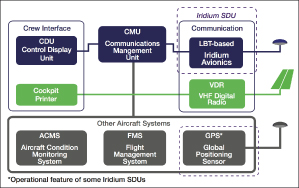 The AIRCOM Iridium message processor is directly connected to the Iridium gateway through private dedicated leased lines to ensure the bandwidth is unaffected by traffic fluctuations in public networks and to improve data security and protection. The second difference is an interim process while the standardization for the processing of safety messages (such as AEEC623, FANS and ATN (Aeronautical Telecommunications Network) which the Iridium link is not currently approved to carry) is finalized by various industry committees such as AEEC, ICAO (International Civil Aviation Organization) and RTCA (Radio Technical Commission for Aeronautics), and in consultation with airlines, airframers, avionics manufacturers, communications providers, air navigation service providers and regulatory agencies.
The AIRCOM Iridium message processor is directly connected to the Iridium gateway through private dedicated leased lines to ensure the bandwidth is unaffected by traffic fluctuations in public networks and to improve data security and protection. The second difference is an interim process while the standardization for the processing of safety messages (such as AEEC623, FANS and ATN (Aeronautical Telecommunications Network) which the Iridium link is not currently approved to carry) is finalized by various industry committees such as AEEC, ICAO (International Civil Aviation Organization) and RTCA (Radio Technical Commission for Aeronautics), and in consultation with airlines, airframers, avionics manufacturers, communications providers, air navigation service providers and regulatory agencies.
The ADLT processor has been modified to handle Iridium messages as it would handle those from other links; this handling may, however, need to be temporarily or permanently modified, subject to guidance and standards from the industry bodies mentioned above. In terms of link management, as with other ACARS media, the Iridium link is handled by AIRCOM as dictated by customers’ business policies to suit their operational needs and commercial requirements. Lastly, the Iridium ACARS traffic is exchanged between the ADLT and the airline host using the same protocols and network connections as other ACARS traffic.
Suitability for airline operations
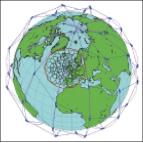 Iridium’s global coverage makes it an ideal service to complement SITA AIRCOM’s VHF network in areas of limited coverage or where deploying ground stations is impractical. Iridium also allows SITA to provide continuous coverage for voice and ACARS communications services in higher latitudes and Polar Regions which are beyond the reach of other satellite constellations. From an avionics perspective, in addition to a single onboard satellite data unit (SDU), Iridium’s use of LEO satellites only requires a low-gain antenna to be mounted on the aircraft fuselage. These minimal requirements simplify the avionics installation in terms of aircraft downtime, physical space, wiring and certification.
Iridium’s global coverage makes it an ideal service to complement SITA AIRCOM’s VHF network in areas of limited coverage or where deploying ground stations is impractical. Iridium also allows SITA to provide continuous coverage for voice and ACARS communications services in higher latitudes and Polar Regions which are beyond the reach of other satellite constellations. From an avionics perspective, in addition to a single onboard satellite data unit (SDU), Iridium’s use of LEO satellites only requires a low-gain antenna to be mounted on the aircraft fuselage. These minimal requirements simplify the avionics installation in terms of aircraft downtime, physical space, wiring and certification.
Aircraft operators therefore benefit not just from lower upfront equipment acquisition and retrofit costs and fuel savings (due to lighter equipment and less antenna drag), but also the operational efficiencies derived from having access to a global voice and ACARS communications network. In terms of operational efficiencies, the Iridium link continues to facilitate access to the benefits that AIRCOM customers currently enjoy through AOC (Aeronautical Operational Control)- voice and ACARS communications. It is also expected that once Iridium is approved for ATS communications, it will lead to more efficient operations and lower communication and navigation charges.
Avionics equipment
The AIRCOM Iridium voice and ACARS services offering relies on customers’ aircraft being adequately equipped with avionics capable of accessing and interacting with the AIRCOM network. Iridium has contracted Celestica to manufacture satellite L-band transceivers (LBT) and SBD devices containing Iridium subscriber units (ISUs). The avionics required to support the Iridium network consist of an SDU and a suitable antenna. The SDU typically houses the Iridium LBTs, SBD devices and the I/O (Input/Output) processors to interface with existing aircraft voice and/or data communications systems.
These systems may include cockpit audio control systems, ACARS communication management system – i.e., MU (management unit) or CMU (communication management unit), control display units – eg. CDU (control display unit) or MCDU (Multi-purpose control display unit) etc. The ACARS Iridium service offered by SITA requires the installation of an SDU that is capable of sending/receiving messages to/from an ACARS MU or CMU. SITA is working with avionics manufacturers of Iridium equipment to ensure their compatibility with the AIRCOM network and various avionics systems using the AEEC618 and other industry-standard protocols. One key advantage of Iridium’s LEO satellite configuration is the small distances that signals travel between satellites and aircraft, which eliminate the need to install high-gain antennas and high-power amplifiers in the aircraft. For aircraft operators, this advantage translates into reduced upfront avionics equipment and aircraft retrofit costs, which have traditionally made it uneconomical to install satellite equipment in short- and medium-haul fleets as well as in older aircraft.
Avionics vendors
In broad terms, there are fewer than a dozen Iridium avionics vendors of interest for the ATI. Their products range from application-specific, mostly for maintenance and fleet-tracking purposes, through basic datalink functions with generic and aviation-specific interfaces, to ACARS over Iridium-capable units.
Most of them provide a dedicated or shared data channel and can be interfaced to a handset or audio control system for voice communications. It is important to highlight that there are other vendors of portable equipment (i.e., not aircraftmounted) or not specifically designed for aviation data applications, so these are not considered as being of “interest” at this time.
Since most of the Iridium avionics vendors launched their offerings for the business/corporate aviation market, their solutions tend to rely on proprietary air/ground protocols which communicate only with their own ground-based applications, so they are not readily compatible with ACARS or the ground systems typically used by airlines; nonetheless, SITA is following the developments in the Iridium avionics market closely in case new offerings aimed at the air transport market become available.
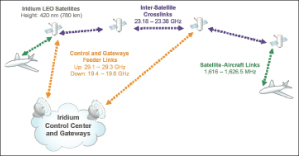 The ACARS-capable Iridium units essentially emulate an Inmarsat SATCOM SDU, so they can be connected to the ACARS CMU in lieu of an Inmarsat SDU. The aim of this architecture (Figure 3) is to avoid or minimize, if at all possible, any changes that may require a software change or upgrade to the ACARS CMU. SITA is working with most avionics vendors of ACARS over Iridium-capable units to implement industry standards through AEEC and RTCA to allow the avionics to communicate with airlines’ legacy and IP-based systems using the ACARS protocols – in essence, making the Iridium link another medium just like VHF, VDL or Inmarsat SATCOM, and its operation entirely transparent to ACARS end-users.
The ACARS-capable Iridium units essentially emulate an Inmarsat SATCOM SDU, so they can be connected to the ACARS CMU in lieu of an Inmarsat SDU. The aim of this architecture (Figure 3) is to avoid or minimize, if at all possible, any changes that may require a software change or upgrade to the ACARS CMU. SITA is working with most avionics vendors of ACARS over Iridium-capable units to implement industry standards through AEEC and RTCA to allow the avionics to communicate with airlines’ legacy and IP-based systems using the ACARS protocols – in essence, making the Iridium link another medium just like VHF, VDL or Inmarsat SATCOM, and its operation entirely transparent to ACARS end-users.

